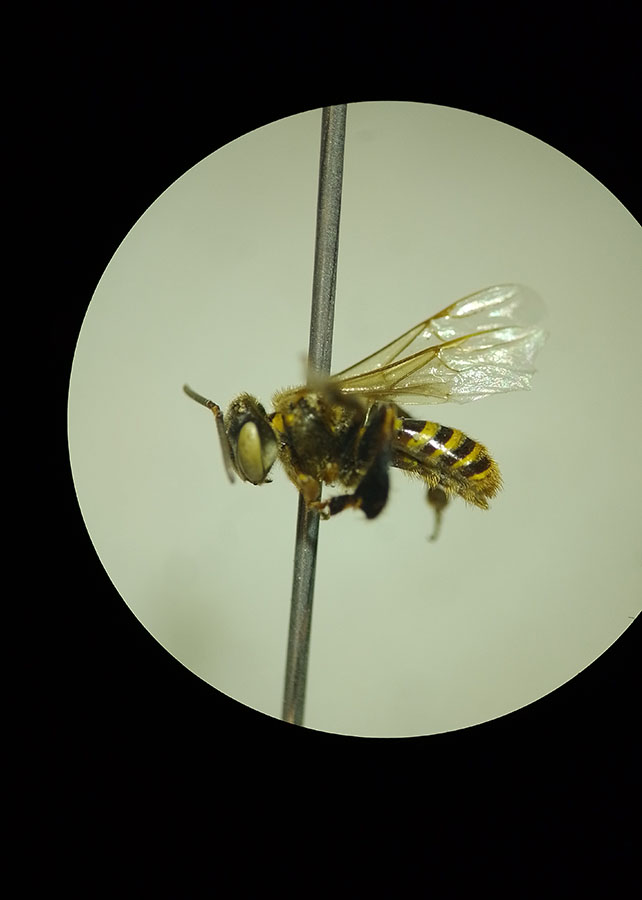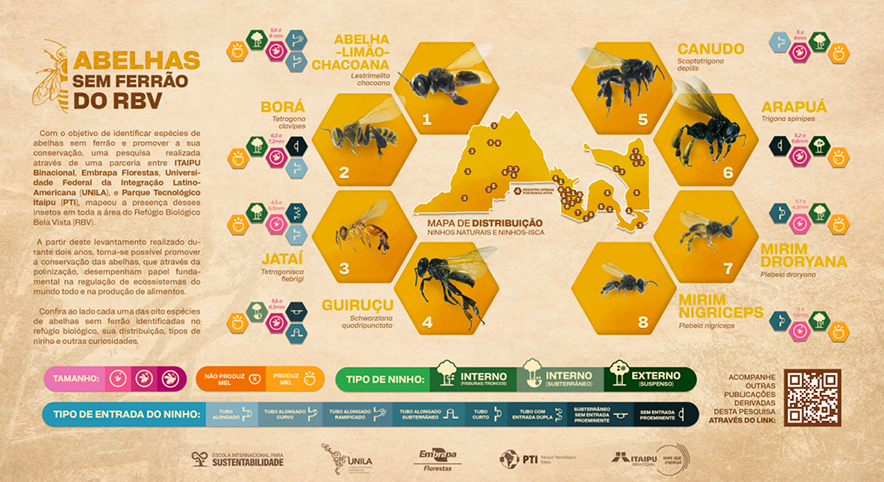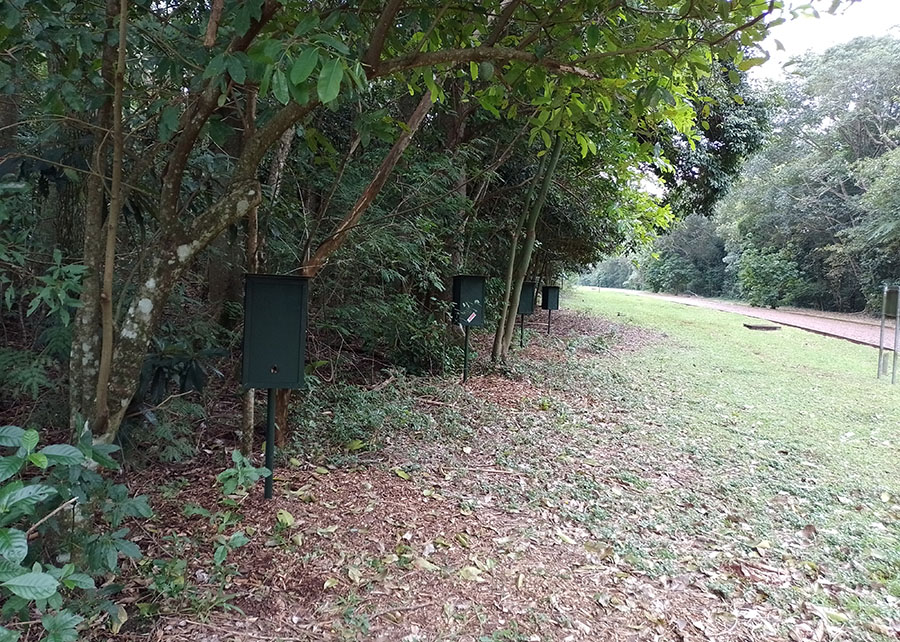Data obtained between 2021 and 2023 contribute to the conservation of local biodiversity, as they indicate the species most adapted to the region The research teams established protocols to assess, identify and record all native bee species found on site according to their taxonomy. The work resulted in the establishment of two stingless bee collections: a live one at the Bela Vista Ecological Refuge (RBV), and a reference one at Itaipu Technological Park (PTI). Another important aspect is the possibility of future molecular studies with bee DNA extraction. The identification of adapted species supports breeding within their area of occurrence, given its climate, temperature and vegetation. Their rational management opens new sources of income for local populations, as their honey can be up to ten times more expensive than the traditional one produced by European bees. A joint survey by Embrapa Forestry, Itaipu Binacional, Itaipu Technological Park (PTI) and the Federal University of Latin American Integration (Unila) identified eight species of stingless bees in Itaipu Binacional's Bela Vista Biological Refuge (RBV). They are native to Paraná, other regions of Brazil and countries in South America. The stingless bees also known as meliponines play a fundamental role in maintaining ecosystems as they pollinate plants. The findings contribute to the conservation of local biodiversity, once they not only indicate the species that are most adapted to the region, but also support public policies for native bee-keeping in the state. The survey was held between 2021 and 2023, within the scope of the project “Diagnóstico e conservação da fauna de Hymenoptera em áreas naturais da Itaipu Binacional, com ênfase em espécies da tribo Meliponini” [Diagnosis and conservation of Hymenoptera fauna in natural areas in Itaipu Binacional, with emphasis on species from the Meliponini tribe]. The initiative's supervisor at Itaipu, Edson Zanlorensi, explains that the teams established protocols to assess, identify and record all the field-inventoried bees in the Refuge area. “Samples of all the species found in natural nests, captured colonies, artificial baits and colonies installed in thermal boxes were collected, organized, and identified according to taxonomy”, he says. According to Guilherme Schühli,a researcher at Embrapa Forestry who is responsible for the project and its composition, this study could also allow further considerations about the area and on how conservation initiatives impact the region. “Moreover, Paraná has pioneering public policy initiatives for native beekeeping, and our diagnosis contributes to suitable directions for conservation efforts, especially for the west of the state”, he underscores. PTI's environmental analyst Flavia Rodriguez notes the synergy between the institutions involved and recalls that this type of initiative contributes to consolidating the Park's mission, namely to “transform knowledge and innovation into social welfare and, in this case, contribute to the understanding of the species that compose part of the territory and their ecosystem services”. Survey In order to start the survey, as the Embrapa Forestry researcher explains, firstly a diagnosis of the species of stingless bees present was required. The studied area covers around two hectares, where Itaipu Binacional and the Bela Vista Biological Refuge are. That region, which is located in the west of Paraná state in southern Brazil, shows both natural vegetation and areas of human intervention, such as reforestation areas implemented by Embrapa Forestry 30 years ago, where meliponines were also sampled. “The sampling drew lines called transects, where we collected insects in every season of the year, with the aim to understand all the plant formations present in the Itaipu and RBV area. To ensure that we were covering the entire bee diversity, there were also collections outside the transects, when we would verify insect movements, flowering plants or even reports from employees about their presence”, Schühli reports. Hand nets and nest baits containing a beeswax mixture as a lure were used to attract and capture bees in the designed sampling area. In addition to the collections, the researchers searched for records about stingless bees in international bibliographic sources and in insect collections. “We carried out a survey of the history of bees that had already been collected in the region in other initiatives. In general, biological collections make listings (record specimens), which makes it possible to verify what was actually collected and what was identified by a specialist”, he explains. “The comprehensiveness of the protocol design led to a broad survey of bee species in the western region of Paraná, which is still understudied, unlike the metropolitan region of Curitiba, which is a reference in the study of stingless bees”, he adds. Results The research work resulted in the establishment of two collections of stingless bees. The live collection, with bees that are kept in rational boxes, is located at the Bela Vista Biological Refuge. The reference collection, with samples of what was collected and identified (including preserved bees), is stored in the Danúncia Urban entomological collection (pictured on the left), at Unila, located within the Itaipu Technological Park. Unila's researcher and professor Fernando Zanella remarks that the research allowed for an inventory of the diversity of stingless bees and their distribution in the refuge's space, making it possible to recognize the value of the area as a shelter for those bees. “The effort of sampling, especially nests, allowed us to expand the nursery at Itaipu's meliponary, whose purpose is environmental education and tourism, and becomes a reference for sampling in other areas of the region”, Zanella observes. Another important aspect highlighted by the Embrapa Forestry researcher is the possibility of future molecular studies. “This study is a very good picture, so that we can later check the progression of stingless bees in the region. In addition, the bees deposited in the collection contain other important biological information, such as the pollen they carry on their bodies when they are captured. All of that is recorded, making it possible to identify which trees offer such food, and hence estimate the number of individuals during that period”, Schühli explains. That is possible because part of the animals are preserved in a wet collection, in 70% alcohol, which allows for future molecular analyses, with DNA extraction from the bees. Management and protection In addition, the initiative established management protocols for the Melipona bees and developed a protective module for the bee boxes that allows colonies to be set up in open areas. Such modules protec the bees from predators like monkeys, opossums and others. According to Schühli, the initiative also benefits neighbouring communities, as it contributes to maintaing those species in the outskirts of the refuge. “There is large interest in stingless beekeeping and the Biological Refuge has large potential to become a reference and a space for dissemination not only of techniques, but also of live material within Itaipu's environment”, the researcher adds. The bee species identified Borá (Tetragona clavipes) Jataí (Tetragonisca fiebrigi) Guiruçu (Schwarziana quadripunctata) Canudo (Scaptotrigona depilis) Arapuá (Trigona spinipes) Mirim Droryana (Plebia droryana) Mirim Nigriceps (Plebeia nigriceps) "Lemon bee" (Lestrimelitta chacoana). Correction - After this news was initially published in Portuguese, the following points had to be corrected with regard to the "Lemon bee": The species in question was first documented for Brazil in the state of Mato Grosso do Sul, by Lima, F.V.O., Silvestre, R. (2017) followed by a record in Paraná state on September 18, 2023, by Me, given the lo, G. A.R.(2023) . The latter publicaton mentions a specimen precisely in the Biological Refuge. The 2023 study took place simultaneously with the work that resulted in the project. Therefore, while the record reported herein was not the first in Brazil, it still represents a significant contribution, given the number captured, the location of natural nests and the filing of all voucher specimens.
Photo: Guilherme Schühli
![Guilherme Schühli - The bee box' protective module allows colonies to be set up in open areas and protects bees from predators Guilherme Schühli - The bee box' protective module allows colonies to be set up in open areas and protects bees from predators]()
The bee box' protective module allows colonies to be set up in open areas and protects bees from predators
A joint survey by Embrapa Forestry, Itaipu Binacional, Itaipu Technological Park (PTI) and the Federal University of Latin American Integration (Unila) identified eight species of stingless bees in Itaipu Binacional's Bela Vista Biological Refuge (RBV). They are native to Paraná, other regions of Brazil and countries in South America. The stingless bees also known as meliponines play a fundamental role in maintaining ecosystems as  they pollinate plants. The findings contribute to the conservation of local biodiversity, once they not only indicate the species that are most adapted to the region, but also support public policies for native bee-keeping in the state.
they pollinate plants. The findings contribute to the conservation of local biodiversity, once they not only indicate the species that are most adapted to the region, but also support public policies for native bee-keeping in the state.
The survey was held between 2021 and 2023, within the scope of the project “Diagnóstico e conservação da fauna de Hymenoptera em áreas naturais da Itaipu Binacional, com ênfase em espécies da tribo Meliponini” [Diagnosis and conservation of Hymenoptera fauna in natural areas in Itaipu Binacional, with emphasis on species from the Meliponini tribe]. The initiative's supervisor at Itaipu, Edson Zanlorensi, explains that the teams established protocols to assess, identify and record all the field-inventoried bees in the Refuge area. “Samples of all the species found in natural nests, captured colonies, artificial baits and colonies installed in thermal boxes were collected, organized, and identified according to taxonomy”, he says.
According to Guilherme Schühli,a researcher at Embrapa Forestry who is responsible for the project and its composition, this study could also allow further considerations about the area and on how conservation initiatives impact the region. “Moreover, Paraná has pioneering public policy initiatives for native beekeeping, and our diagnosis contributes to suitable directions for conservation efforts, especially for the west of the state”, he underscores.
PTI's environmental analyst Flavia Rodriguez notes the synergy between the institutions involved and recalls that this type of initiative contributes to consolidating the Park's mission, namely to “transform knowledge and innovation into social welfare and, in this case, contribute to the understanding of the species that compose part of the territory and their ecosystem services”.
Survey
In order to start the survey, as the Embrapa Forestry researcher explains, firstly a diagnosis of the species of stingless bees present was required. The studied area covers around two hectares, where Itaipu Binacional and the Bela Vista Biological Refuge are. That region, which is located in the west of Paraná state in southern Brazil, shows both natural vegetation and areas of human intervention, such as reforestation areas implemented by Embrapa Forestry 30 years ago, where meliponines were also sampled.
“The sampling drew lines called transects, where we collected insects in every season of the year, with the aim to understand all the plant formations present in the Itaipu and RBV area. To ensure that we were covering the entire bee diversity, there were also collections outside the transects, when we would verify insect movements, flowering plants or even reports from employees about their presence”, Schühli reports. Hand nets and nest baits containing a beeswax mixture as a lure were used to attract and capture bees in the designed sampling area.
In addition to the collections, the researchers searched for records about stingless bees in international bibliographic sources and in insect collections. “We carried out a survey of the history of bees that had already been collected in the region in other initiatives. In general, biological collections make listings (record specimens), which makes it possible to verify what was actually collected and what was identified by a specialist”, he explains. “The comprehensiveness of the protocol design led to a broad survey of bee species in the western region of Paraná, which is still understudied, unlike the metropolitan region of Curitiba, which is a reference in the study of stingless bees”, he adds.

 Results
Results
The research work resulted in the establishment of two collections of stingless bees. The live collection, with bees that are kept in rational boxes, is located at the Bela Vista Biological Refuge. The reference collection, with samples of what was collected and identified (including preserved bees), is stored in the Danúncia Urban entomological collection (pictured on the left), at Unila, located within the Itaipu Technological Park. Unila's researcher and professor Fernando Zanella remarks that the research allowed for an inventory of the diversity of stingless bees and their distribution in the refuge's space, making it possible to recognize the value of the area as a shelter for those bees. “The effort of sampling, especially nests, allowed us to expand the nursery at Itaipu's meliponary, whose purpose is environmental education and tourism, and becomes a reference for sampling in other areas of the region”, Zanella observes.
Another important aspect highlighted by the Embrapa Forestry researcher is the possibility of future molecular studies. “This study is a very good picture, so that we can later check the progression of stingless bees in the region. In addition, the bees deposited in the collection contain other important biological information, such as the pollen they carry on their bodies when they are captured. All of that is recorded, making it possible to identify which trees offer such food, and hence estimate the number of individuals during that period”, Schühli explains. That is possible because part of the animals are preserved in a wet collection, in 70% alcohol, which allows for future molecular analyses, with DNA extraction from the bees.
 Management and protection
Management and protection
In addition, the initiative established management protocols for the Melipona bees and developed a protective module for the bee boxes that allows colonies to be set up in open areas. Such modules protec the bees from predators like monkeys, opossums and others. According to Schühli, the initiative also benefits neighbouring communities, as it contributes to maintaing those species in the outskirts of the refuge. “There is large interest in stingless beekeeping and the Biological Refuge has large potential to become a reference and a space for dissemination not only of techniques, but also of live material within Itaipu's environment”, the researcher adds.
The bee species identified Borá (Tetragona clavipes) Jataí (Tetragonisca fiebrigi) Guiruçu (Schwarziana quadripunctata) Canudo (Scaptotrigona depilis) Arapuá (Trigona spinipes) Mirim Droryana (Plebia droryana) Mirim Nigriceps (Plebeia nigriceps) "Lemon bee" (Lestrimelitta chacoana). Correction - After this news was initially published in Portuguese, the following points had to be corrected with regard to the "Lemon bee": The species in question was first documented for Brazil in the state of Mato Grosso do Sul, by Lima, F.V.O., Silvestre, R. (2017) followed by a record in Paraná state on September 18, 2023, by Me, given the lo, G. A.R.(2023) . The latter publicaton mentions a specimen precisely in the Biological Refuge. The 2023 study took place simultaneously with the work that resulted in the project. Therefore, while the record reported herein was not the first in Brazil, it still represents a significant contribution, given the number captured, the location of natural nests and the filing of all voucher specimens. |
Manuela Bergamim (MTb 1.951/ES)
Embrapa Forestry
Press inquiries
florestas.imprensa@embrapa.br
Phone number: +55 41 3675-5638
Translation: Mariana Medeiros (13044/DF)
Superintendency of Communications
Further information on the topic
Citizen Attention Service (SAC)
www.embrapa.br/contact-us/sac/

 they pollinate plants. The findings contribute to the conservation of local biodiversity, once they not only indicate the species that are most adapted to the region, but also support public policies for native bee-keeping in the state.
they pollinate plants. The findings contribute to the conservation of local biodiversity, once they not only indicate the species that are most adapted to the region, but also support public policies for native bee-keeping in the state.
 Results
Results Management and protection
Management and protection